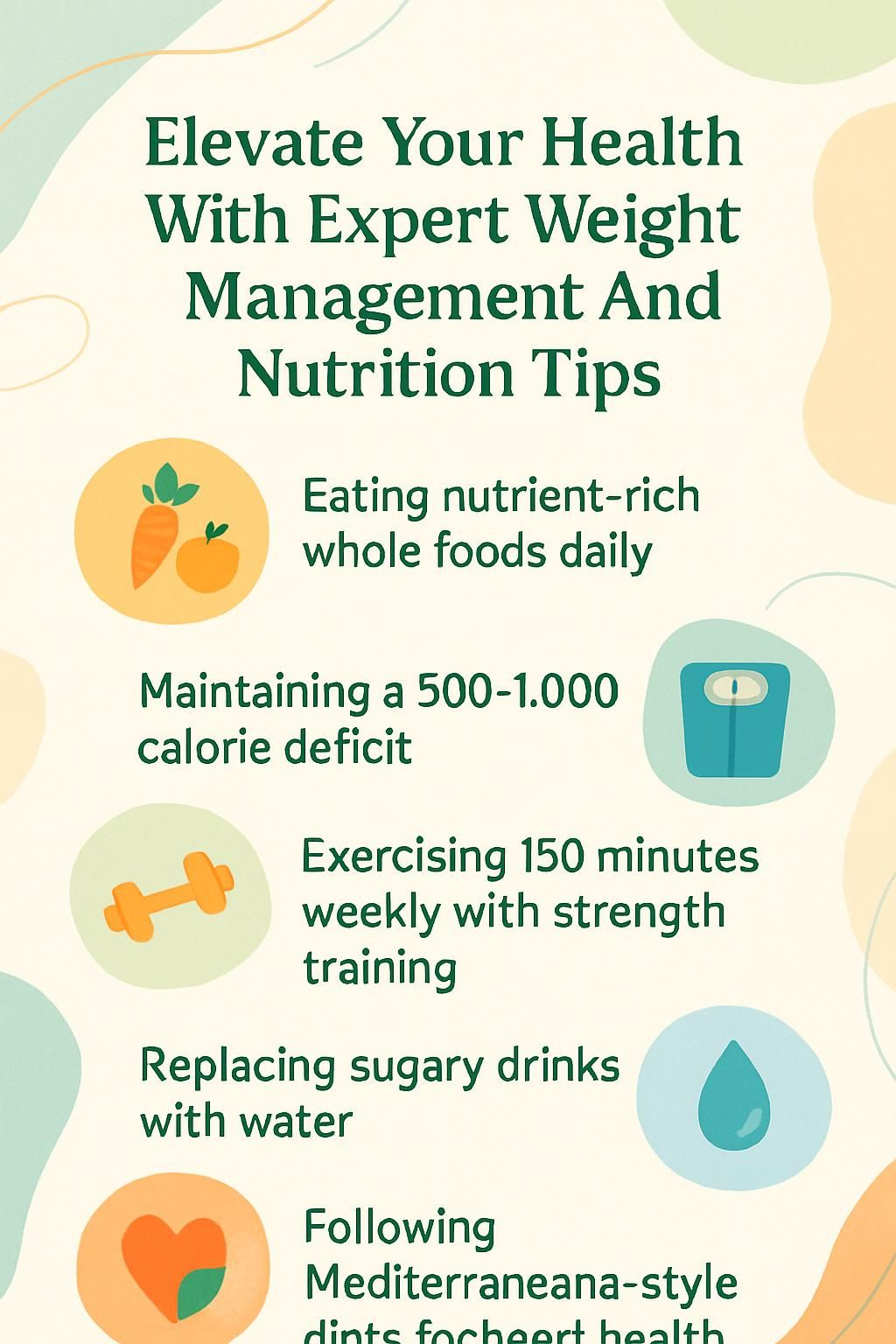Elevate Your Health With Expert Weight Management And Nutrition Tips
Our Nutrition Assistant AI Suite will transform your body. You will lose fat, get toned, and build muscle. Gain confidence and optimal health.
Weight management can feel confusing, especially with so many diet claims online. The core is simple: healthy eating and steady physical activity shape a healthy weight. Small daily habits stack up over time and protect long-term health.
This guide shares evidence-based tips you can use today. You will learn how calories work, which foods help you stay full, and how to build routines that last. Expect clear steps, plain language, and ideas you can try this week.
Key Takeaways
- Healthy weight management starts with nutrient-rich whole foods and consistent calorie tracking, aiming for a daily deficit of 500 to 1,000 calories to lose about 1 to 2 pounds per week.
- Regular physical activity of at least 150 minutes weekly, plus strength training, supports long-term weight control and lowers risk for diabetes and heart disease.
- Swap sugary drinks for water, limit processed foods high in added sugars, and read food labels to reduce obesity risk, based on CDC, NIH, and American Heart Association guidance.
- Set SMART goals, monitor meals and exercise with diaries or apps, and use professional or peer support programs like VA MOVE! to stay accountable.
- Research such as the PREDIMED trial (2013) shows Mediterranean-style eating reduces cardiovascular disease by emphasizing fruits, vegetables, whole grains, lean proteins, and healthy fats.

Key Elements of Weight Management

Effective weight management protects your health and lowers chronic disease risk. Knowing the main elements helps you choose daily actions that support sustainable weight loss and maintenance.
What is weight management and why is it important?
Weight management means keeping your body weight in a healthy range through food choices, physical activity, and daily habits. Many people use BMI, or body mass index, to estimate whether weight fits height.
Evidence from the Centers for Disease Control and Prevention shows that reaching and maintaining a healthy weight lowers the risk of obesity, type 2 diabetes, and heart disease. Even a modest loss of 1 to 2 pounds per week can improve health markers.
Realistic goals and steady habits beat extreme diets. A practical plan is easier to follow, and it makes weight maintenance more likely.
What common challenges affect weight management?
Busy schedules often push fast food or skipped meals. Large restaurant portions and packaged foods can add more calories than you need for balance. A 12-ounce soda can supply about 10 teaspoons of added sugar, which adds up fast.
Stress and short sleep can disrupt appetite hormones and drive cravings. Fad diets may cause quick loss, then quick regain, and they can limit key nutrients. A food diary or app helps you spot patterns, portion problems, and triggers.
Consistent, small changes—like reducing sweetened beverage intake—can result in greater weight control and better health over time.
Nutrition’s Impact on Weight Management
Food choices shape your energy balance each day. Clinical nutrition research shows that focusing on calorie awareness and whole foods supports successful weight management.
How do calories affect weight control?
Calories are units of energy. If you eat more than you burn, the extra is stored as fat tissue, which leads to weight gain. Eating fewer calories than you burn creates a deficit, which leads to weight loss.
Guidelines from the National Institutes of Health and the Dietary Guidelines Advisory Committee suggest a calorie deficit of 500 to 1,000 per day for a loss of 1 to 2 pounds per week. Tracking intake helps you stay consistent and manage portions.
Simple swaps go a long way. Choose water over sugary drinks. Pick whole grains and lean proteins instead of refined or highly processed foods. These changes lower calories while keeping you full, which supports heart and metabolic health.
What are nutrient-rich whole foods to include?
Nutrient-rich whole foods deliver vitamins, minerals, fiber, and healthy fats. They increase fullness, support your metabolism, and reduce disease risk.
- Fruits and vegetables, aim for at least five servings daily to increase fullness with fewer calories.
- Whole grains like brown rice, oats, quinoa, and whole-wheat bread for more fiber and a lower glycemic impact.
- Lean proteins such as chicken, fish, beans, tofu, and lentils to protect muscle and curb hunger.
- Nuts and seeds for healthy fats and crunch. Watch portions since calories are dense.
- Healthy fats from olive oil, avocado, and salmon to support heart health and nutrient absorption.
- Low-fat dairy or fortified plant milks and yogurts for calcium and protein.
- Water for hydration and appetite control. Keep a bottle nearby.
- Limit processed foods high in added sugars, sodium, and unhealthy fats to lower obesity risk.
Why is hydration essential for weight management?
Hydration supports appetite control and energy. Many people mistake thirst for hunger, which can lead to extra snacking.
Drinking water before meals can reduce calorie intake. Sugary drinks are a major source of added sugars in the United States. Replacing soda with water helped me lose about ten pounds over a few months, and I felt more alert in the afternoon.
Track drinks in a simple log to spot patterns. Studies in the American Journal of Clinical Nutrition show that swapping sugar-sweetened drinks for water cuts calories and lowers obesity risk.
How can reducing processed foods and sugars help?
Cutting processed foods and added sugars reduces extra calories and sodium. One can of regular soda contains around 10 teaspoons of added sugar, which can push you above daily limits fast.
Many Americans exceed these limits and face higher risk for obesity, type 2 diabetes, and high blood pressure. Reading Nutrition Facts Labels helps you spot added sugars and refined ingredients. Choosing whole foods improves diet quality and makes cravings easier to manage.
Preparing meals at home, packing snacks like nuts and fruit, and planning ahead reduce last-minute choices that derail progress.
Dietary Practices for Better Weight Control
Daily eating habits shape your results. Structured meals, smart snacks, and mindful portions keep you on track.
Why should you eat regular, balanced meals?
Balanced meals stabilize energy and prevent rebound hunger. People who eat three meals a day, including breakfast, are more likely to keep weight off over time, based on national registry data.
Skipping meals often leads to overeating later. Build plates with lean protein, whole grains, and vegetables. Oatmeal with berries and nuts or a salad with grilled chicken are simple examples. Cooking at home gives you better control over ingredients and portion sizes.
What are healthy nutrient-dense snack options?
Smart snacks help you stay satisfied between meals and avoid overeating later. Aim for fiber, protein, or both.
- Fresh fruit, such as apples or oranges, for fiber and natural sweetness.
- Unsalted nuts for healthy fats, protein, and minerals that support heart health.
- Low-fat or Greek yogurt for protein and probiotics that support digestion.
- Cut vegetables, such as carrots, cucumbers, and bell peppers, for crunch and fiber.
- Whole-grain crackers with hummus for plant protein and steady energy.
- Cottage cheese with berries for protein, calcium, and antioxidants.
- Boiled eggs for a quick protein option that keeps you full.
- Unsweetened dried fruit with nuts for a portable, balanced snack, watch portions.
- Water or herbal tea instead of sugary drinks to pair with snacks.
- Use MyPlate ideas to add variety and fit your needs at home or on the go.
Trials in adults with overweight show that higher protein and fiber snacks can reduce daily calories and support gradual weight loss.
How can portion control and mindful eating improve weight?
Smaller dishes and measured servings can lower calorie intake without leaving you hungry. The MyPlate visual makes it easy, fill half your plate with vegetables, then add lean protein and whole grains.
Mindful eating means paying attention to hunger and fullness cues. Studies suggest mindful eating can trim calorie intake without strict rules. Choose snacks like yogurt or nuts to boost fullness and improve weight outcomes.
Using simple steps such as reflect, replace, and reinforce can help you stick with balanced patterns like Mediterranean or plant-forward styles.
How do you read food labels correctly?
Start with the serving size. Then check calories, saturated fat, sodium, added sugars, fiber, and protein. A 12-ounce soda often lists 150 calories and 39 grams of added sugars for one serving.
Scan the ingredient list for high fructose corn syrup and hydrogenated oils. Keep sodium below 2,300 milligrams per day, which aligns with national guidance. Using label details in a food diary helped me spot sneaky added sugars and cut back with less effort.
Incorporating Physical Activity
Movement is a powerful partner to nutrition. Think of exercise as a daily deposit that grows your health savings.
What are the benefits of regular exercise?
Regular exercise helps manage your weight and reduces chronic disease risk. Aim for at least 150 minutes of moderate activity, or 75 minutes of vigorous activity, each week.
Walking is an easy place to start. Consistent movement improves heart function, supports immune health, and lifts mood. Reviews of randomized controlled trials show that people who stay active lose weight and keep it off more often.
I started a daily walk last year. Within weeks my energy rose, and my waist size dropped.
Which exercises are most effective for weight management?
Choose activities you enjoy, then build a weekly mix for best results.
- Walking, brisk 30-minute sessions most days meet national guidelines.
- Strength training, at least two sessions per week to build muscle and raise metabolism.
- Cycling, 45 to 60 minutes, three to five times per week for heart and leg strength.
- Swimming or water aerobics for a joint-friendly full-body workout.
- Aerobic options, jogging, dance, or HIIT to increase calorie burn efficiently.
- Yoga or Pilates to improve mobility and reduce stress-driven eating.
- Pick activities you can sustain. VA Health Care resources provide beginner tips.
- Mix moderate and vigorous sessions across the week to support heart and weight goals.
This variety supports weight control, reduces obesity-related risk, and aligns with evidence from controlled trials.
How does strength training boost metabolism?
Strength training builds muscle, and muscle burns more calories at rest than fat. Adults who lift weights twice per week often lose more fat and keep it off longer than those who skip it, according to research reported by professional groups.
Track sessions in an activity diary for accountability. Programs like MOVE! encourage adding strength work to support body composition and long-term weight maintenance.
How do you choose enjoyable, sustainable activities?
Start with what feels fun. Walk with a friend, try a group class, or join a weekend sport. Enjoyment increases consistency, and consistency builds progress.
Fit activity into your schedule, like short morning walks or evening bike rides. Support from peers or a coach can help you stick with it when motivation dips.
Lifestyle and Weight Management
Daily routines shape your results more than single big efforts. Healthy habits add structure that makes progress easier to repeat.
How does sleep affect weight regulation?
Good sleep helps regulate appetite hormones, including leptin and ghrelin. Less than seven hours per night raises the risk of weight gain and obesity.
Stronger sleep habits can reduce cravings for high-calorie foods. Try a consistent bedtime, a dark room, and screens off one hour before bed. Getting eight hours of quiet rest helped me avoid late-night snacks and stick with my plan.
How can stress lead to emotional eating?
Stress raises cortisol, a hormone that can drive cravings for sugary and fatty foods. Emotional eating often happens without real hunger, which adds extra calories.
Healthy coping tools include exercise, breathing practice, or brief meditation. Track mood and meals together to spot stress patterns. Family-based strategies help kids and teens learn skills early.
How do you develop consistent, healthy routines?
Routines make healthy choices automatic. Plan simple steps, then repeat them until they feel normal.
- Set SMART goals that are specific, measurable, attainable, relevant, and time-bound.
- Plan weekly meals with lean proteins, whole grains, and lower glycemic choices.
- Schedule at least 150 minutes of moderate exercise each week.
- Log food and activity in an app or journal to stay aware.
- Build regular times for family meals, movement, and sleep.
- Stock healthy options like fruit, yogurt, and nuts, keep them visible.
- Use supportive groups or professionals to reinforce progress.
- Protect sleep with a steady bedtime and morning routine.
- Use checklists or digital tools to review goals each day.
- Practice mindful eating, pause mid-meal and rate fullness before continuing.
Professional Insights on Weight Management
Expert guidance can shorten the learning curve. Support adds structure, clarity, and accountability.
How do you set achievable and realistic goals?
Set a pace that fits your health status and schedule. Many experts suggest aiming to lose about 1 to 2 pounds per week, which improves the chance of keeping weight off.
Calculate your starting BMI to learn a healthy range. Break big targets into smaller steps, such as the first 10 pounds, then reassess. Use SMART actions, for example, replace sugary drinks with water or walk 30 minutes five days a week.
Data from the National Weight Control Registry show that consistent tracking and smaller goals help people maintain weight loss. Talk with your clinician before trying diets like keto or Atkins, especially if you manage diabetes or take medications.
How can you monitor your food and activity?
Tracking builds awareness and highlights what works. Use simple tools and repeat them daily.
- Keep a food and beverage diary to capture portions and added sugars.
- Use an activity log to note type, duration, and intensity.
- Weigh in weekly at the same time to spot trends, not day-to-day swings.
- Use a Hunger and Fullness Scale before and after meals to guide portions.
- Check labels for serving size, calories, sodium, and added sugars.
- Log calories with an app if weight loss is a goal, barcode scanning can help.
- Record walking, strength sessions, or fasting windows to compare with results.
- Join a supportive group or work with a professional for structured check-ins.
- Review logs weekly to find triggers and plan fixes for the next week.
Monitoring improves long-term success because it keeps you engaged with your plan every day.
What strategies help maintain motivation and inspiration?
Set short goals and track progress with simple charts. Celebrate small wins to build momentum. A slip is data, not failure, and tomorrow is a fresh start.
Communities and coaches can provide accountability and encouragement. Programs like MOVE! offer tools and support to keep routines steady and engaging.
How can supportive communities or professionals assist you?
Group support increases engagement and follow-through. VA Health Care programs like MOVE! offer classes and groups that share tips and encouragement. Many people find it easier to stay consistent when others walk the path with them.
Registered Dietitian Nutritionists can tailor plans to your needs and health conditions. Diabetes education programs teach calorie and carb monitoring to reduce risk for type 2 diabetes and heart disease. Mental health services can support stress, PTSD, or substance concerns that affect eating and activity.
Meeting with a VA dietitian changed how I viewed portion sizes and made regular meals easier, which helped me maintain results. This content is educational and not a substitute for medical advice. Speak with your healthcare provider for personal guidance.
Current Trends in Nutrition and Diet
Popular patterns can offer structure if they fit your life. Choose an approach that you can practice for months, not days.
What is the Mediterranean diet and its benefits?
The Mediterranean diet centers on fruits, vegetables, whole grains, legumes, nuts, fish or poultry, and olive oil. Studies since 2010 link this eating style to lower rates of heart disease and chronic illness.[1] Processed foods, unhealthy fats, and added sugars are limited.
Planning can be simple. Try salmon with roasted vegetables, or Greek yogurt with nuts and fruit. Many people report steady energy and improved fullness, which supports long-term weight management.
…
[1] Data from large population studies such as PREDIMED, Spain, tracked more than 7,000 participants starting in 2013.
How does a plant-based diet support weight management?
Plant-based eating focuses on vegetables, fruits, whole grains, and legumes while limiting animal products and added sugars. These meals tend to be lower in calories and higher in fiber, which helps you feel full on fewer calories.
Low-glycemic choices, like beans and oats, can stabilize blood sugar and reduce hunger swings. Try steel-cut oats for breakfast or hummus with carrot sticks for a snack. After switching to plant-based lunches, I felt less sluggish and saw steady progress by week three.
What should you know about low-carb and ketogenic diets?
Low-carb and ketogenic diets reduce carbohydrate intake to encourage the body to burn fat for fuel. Typical plans limit bread, rice, most fruit, and starchy vegetables. Meals highlight lean proteins, healthy fats, and non-starchy vegetables.
Read labels carefully, some packaged “low-carb” items are still highly processed. Monitor calories and fat while you track carbs. A registered dietitian can help you follow these plans safely, especially if you take medication or have medical conditions.
How can intermittent fasting be structured effectively?
Intermittent fasting sets eating and fasting windows instead of focusing only on food types. A common format is 16:8, fast for 16 hours and eat during an 8-hour window. Others prefer 12:12 or alternate-day fasting.
Plan balanced meals in the eating window so you meet nutrient needs without overeating. Tracking hunger and fullness can prevent breaking the fast early or binging later. Speak with your clinician before starting intermittent fasting, especially if you have diabetes or take blood sugar medications. IF is not advised for children or for certain health conditions.
Health Concerns Related to Weight
Body weight affects disease risk. The upside is that even small changes can improve health quickly.
How is obesity linked to chronic diseases?
Obesity raises the risk of heart disease, type 2 diabetes, some cancers, and joint problems. Extra body fat can raise blood pressure and make blood sugar control harder. The CDC reports that more than 40 percent of U.S. adults were obese in 2017 to 2020.
Losing 5 to 10 percent of your body weight can improve blood sugar, blood pressure, and cholesterol. Families and veterans can find helpful tools through national programs focused on prevention and support.
How can healthy practices prevent type 2 diabetes?
Keeping a healthy weight helps prevent type 2 diabetes. Research shows that losing 5 to 7 percent of body weight lowers risk and improves blood sugar control.
Choose water over sugary drinks, build meals with whole grains, vegetables, and lean proteins, and be active most days. Use MyPlate resources to plan balanced, diabetes-friendly meals. VA Health Care offers Diabetes Self-Management Education and Support for extra guidance.
What are the cardiovascular benefits of a healthy weight?
Reaching a healthy weight supports heart and blood vessel health. The American Heart Association reports that maintaining a healthy body weight can cut heart disease risk by as much as half.
Exercise and eating patterns rich in vegetables, fruits, whole grains, and lean proteins lower blood pressure and LDL cholesterol. Programs like MOVE! help veterans pursue weight and heart goals with lower sodium and fewer saturated fats. Tracking blood pressure alongside meals can show early progress and guide next steps.
Example Meal Plan for Effective Weight Management
Planning ahead reduces guesswork. Use these ideas to build a week of balanced, satisfying meals.
What are good fiber- and protein-rich breakfast options?
Oatmeal with berries and nuts delivers fiber and protein for steady energy. Greek yogurt with fruit, or a boiled egg on whole-grain toast, are quick and balanced.
Studies show high-fiber and high-protein breakfasts support fullness and reduce later overeating. The National Weight Control Registry notes many “Successful Losers” start the day with these options. Keep portions in check to align with your goals.
What are healthy lunch ideas with lean proteins and vegetables?
Build lunch around lean proteins and colorful vegetables. A salad with leafy greens, tomatoes, cucumbers, carrots, and bell peppers, topped with grilled chicken, tuna, or tofu, makes a balanced meal.
Use MyPlate for portions, fill half your plate with vegetables, then add protein and a whole grain like quinoa or brown rice. Choose olive oil with vinegar or lemon instead of heavy dressings. A small portion of avocado or seeds adds healthy fats without excess calories.
What dinner choices include whole grains and healthy fats?
Dinner can reinforce your progress with balance and flavor. Try baked salmon, roasted vegetables, and brown rice. Salmon provides omega-3 fats, and whole grains add fiber for fullness.
Use a light drizzle of olive oil, and limit butter or creamy sauces. Keep portions reasonable to meet your calorie goals. Focusing on minimally processed ingredients helps you control sodium and added sugars.
What healthy snack alternatives are available like fruits, nuts, or yogurt?
Choose snacks that keep energy steady and support your plan. Apple slices, carrot sticks, or a small handful of almonds are easy options. Low-fat Greek yogurt offers protein and helps curb cravings.
Cut vegetables with hummus or cheese sticks provide protein and fiber. A 2022 CDC report links produce-rich snacking with lower risk of obesity and type 2 diabetes. Prepping snacks in advance helps with portion control and prevents impulse picks.
Conclusion
Expert strategies for weight management work best when they are simple and repeatable. Build meals from nutrient-rich foods, move most days, sleep well, manage stress, and drink water instead of sugary beverages.
Use food labels to guide choices and keep an easy diary for meals and activity. Walking and strength training form a strong foundation. If you need a personalized plan, seek help from a Registered Dietitian Nutritionist or your healthcare provider.
Small steps, done daily, lead to steady change. Keep your focus on habits you can maintain, and your healthy weight will follow.
FAQs
1. What are the most effective strategies for weight management and nutrition improvement?
Effective strategies include tracking food intake, choosing nutrient-rich foods, and setting realistic goals. Studies show that people who keep a food diary lose twice as much weight compared to those who do not (Journal of the Academy of Nutrition and Dietetics, 2013). My experience with meal planning helped me avoid unhealthy snacks and maintain steady progress. Focus on balanced meals, regular physical activity, and mindful eating for best results.
2. How can I identify nutrient-rich foods to support my health?
Nutrient-rich foods provide high levels of vitamins, minerals, fiber, and protein while being low in added sugars or saturated fats. Examples include leafy greens like spinach or kale; lean proteins such as poultry or beans; whole grains like brown rice; and fruits including berries or oranges. A table comparing calories per serving with vitamin content can help you make informed choices.
3. What role does portion control play in healthy weight management?
Portion control helps prevent overeating by limiting calorie intake without restricting nutrition quality. Research from the Centers for Disease Control shows smaller plate sizes lead to reduced calorie consumption at meals (CDC.gov). In my own routine, using measuring cups made it easier to serve proper amounts at each meal.
4. Can expert tips really improve long-term health outcomes?
Expert guidance based on scientific evidence leads to better habits over time. For example, following registered dietitian advice about balanced macronutrients has been linked with lower risk of chronic diseases such as diabetes or heart disease (Harvard T.H. Chan School of Public Health). Consistent application of these tips supports lasting improvements in both energy levels and overall wellness.
Summary: Using proven strategies like tracking intake, choosing nutrient-dense options, practicing portion control, and seeking expert advice creates a strong foundation for effective weight management and improved nutrition outcomes.







